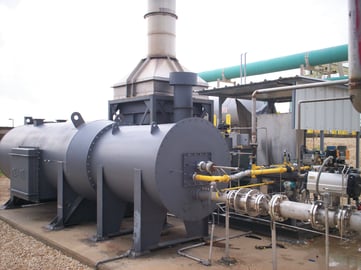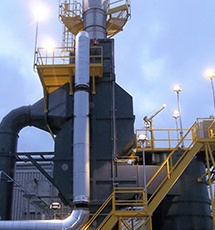Catalytic Products International (CPI) installed a Direct Fired Thermal Oxidizer (DFTO) at a Southwestern USA publicly owned wastewater treatment (WWTP) facility for the abatement of Volatile Organic Compounds (VOCs) and other separated constituents from the wastewater treatment gas separation process.
Renewable natural gas (RNG) is a term used to describe anaerobically-generated biogas that has been upgraded (or refined) for use in place of fossil natural gas. Large wastewater treatment plants are one of the main sources of biogas used to produce RNG. The anaerobic digestion process breaks down organic waste and produces digester gas (biogas). Converting biogas to RNG is a multistep purification process. The composition of wastewater digester gas varies, though the primary constituents are methane (CH4) and carbon dioxide (CO2). Trace amounts of nitrogen gas (N2), oxygen gas (O2), and hydrogen sulfide (H2S) may also be present. As part of the advanced treatment stage of the RNG purification, some CH4 is stripped out as “tail gas,” along with the CO2 and other residual constituents. This tail gas must be destroyed by flaring or thermal oxidization.
 The 600 SCFM QUADRANT NRV- 600 Thermal Oxidizer burns the tail gas from a digester gas conditioning pressure swing adsorption (PSA) system. The thermal oxidizer will destroy VOC emissions with +99% destruction rate efficiency (DRE).
The 600 SCFM QUADRANT NRV- 600 Thermal Oxidizer burns the tail gas from a digester gas conditioning pressure swing adsorption (PSA) system. The thermal oxidizer will destroy VOC emissions with +99% destruction rate efficiency (DRE).
CPI worked closely with the customer and its contractor to engineer, design, and deliver the fully assembled thermal oxidizer including exhaust stack, control panel and flame arrestor. CPI also provided installation supervision, equipment startup and continued aftermarket services.
QUADRANT NRV-Series Systems work by sending the off gas emissions (typically low in volume but high in concentration) as a fuel directly through a special burner system. This unique combustion system is safe and reliable throughout a wide range of conditions and can process LEL ranges from 0 to over 100% without any compromise in safety or efficiency.
The process begins by flowing natural gas into a pilot burner and once ignited, more natural gas is piped into the "hold" burners, as well as the main gas burners. Once the Main gas burners ignite and the temperature increases, the pilot is deactivated.
 As the internal temperature within the combustion chamber increases, combustion air is blown into the system. Some of the combustion air is forced into the venturi system, where it mixes with the natural gas. The rest of the combustion air is driven directly into the combustion chamber, where it helps both to ensure there is enough oxygen content to support oxidation as well as to help maintain combustion chamber temperature.
As the internal temperature within the combustion chamber increases, combustion air is blown into the system. Some of the combustion air is forced into the venturi system, where it mixes with the natural gas. The rest of the combustion air is driven directly into the combustion chamber, where it helps both to ensure there is enough oxygen content to support oxidation as well as to help maintain combustion chamber temperature.
Once the QUADRANT NRV has reached operating temperature, process gases are released into the burner assembly, rather than over it as in other thermal oxidizers. As these gases are released from the process gas nozzles, they interact with the flame from the hold burner and main gas burner, and ignite, adding still more heat to the combustion chamber.
Sensors in the combustion chamber constantly monitor temperature, allowing the PLC to control how much heat is being produced. As the gases heat up, the PLC reduces the amount of natural gas being used, allowing the process stream to be the main fuel source for the oxidizer. It also increases the amount of combustion air being used to help maintain temperature. The same also happens in reverse: If the temperature begins to fall, the main gas use increases, and the combustion air blower decreases.
As long as the air stream being delivered to the NRV is rich in VOCs or other volatile chemicals, the system uses only enough natural gas to keep the hold burners lit. This allows the system to maintain flame on the burner assembly even if there is a sudden drop in VOC concentration. This feature is what allows the VOC to be more fuel efficient than an enclosed flare or a more typical thermal oxidizer.
Established in 1969, Catalytic Products International (CPI) continues as a leading supplier of air pollution control equipment. CPI is at the forefront in providing industries including renewable natural gas (RNG) facilities with solutions to their air pollution control needs.
Today, CPI partners with its customers as a trusted resource in resolving the most complex air pollution and energy conservation problems. We provide our customers with innovative and cost-conscious solutions to their most complex VOC, NOx, and Odor pollution challenges. Our equipment is also at work meeting energy conservation strategies and minimizing greenhouse gas (GHG) emissions.








